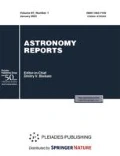Abstract
The characteristics of degenerate dwarfs-core radius, mass, and energy, thickness of their outer layers-are calculated based on a mechanical-equilibrium equation in a five-parameter, two-phase compositemodel with an isothermal core and a non-degenerate outer region. An accurate equation of state for the partially degenerate, ideal, relativistic electron gas of the core is used together with a polytropic approximation for the outer layers. The model parameters are determined using the known masses, radii, and luminosities of observed DA white dwarfs. A region where dwarfs can exist is identified in a plot of core temperature vs. the relativity parameter at the center of the star, and the dependence of the core temperature on the effective temperature of the photosphere is constructed.
Similar content being viewed by others
References
S. Shapiro and S. Teukolsky, Black Holes, White Dwarfs, and Neutron Stars: The Physics of Compact Objects (Mir, Moscow, 1985; Wiley, New York, 1983).
L. G. Althaus, A. H. Corsico, J. Isern, and E. Garcia- Berro, Astron. Astrophys. Rev. 18, 471 (2010).
P.-E. Tremblay, P. Bergeron, and A. Gianninas, Astrophys. J. 730, 128 (2011).
Q. Hu, C. Wu, and X.-B. Wu, Astron. Astrophys. 466, 627 (2007).
M.-M. Limoges and P. Bergeron, Astrophys. J. 714, 1037 (2010).
J. L. Provencal, H. L. Shipman, E. Hog, and P. Thejll, Astrophys. J. 494, 759 (1998).
M.V. Vavrukh, S.V. Smerechinskii, and N. L. Tyshko, Astron. Rep. 55, 505 (2011).
A. Bragaglia, A. Renzini, and P. Bergeron, Astrophys. J. 443, 735 (1995).
P. Bergeron, R. A. Saffer, and J. Liebert, Astrophys. J. 394, 228 (1992).
M. V. Vavrukh and S. V. Smerechinskii, Astron. Rep. 56, 363 (2012).
A. Sommerfeld, Zs. Phys. 47, 1 (1928).
S. Chandrasekhar, An Introduction to the Study of Stellar Structure (Univ. of Chicago, Chicago, 1939; Inostr. Liter., Moscow, 1954).
G. Chabrier, P. Brassard, G. Fontaine, and D. Saumon, Astrophys. J. 543, 216 (2000).
L. G. Althaus, E. Garcia-Berro, J. Isern, et al., Astron. Astrophys. 465, 249 (2007).
J. A. Panei, L. G. Althaus, and O. G. Benvenuto, Mon. Not. R. Astron. Soc. 312, 531 (2000).
Author information
Authors and Affiliations
Corresponding author
Additional information
Original Russian Text © M.V. Vavrukh, S.V. Smerechinskii, 2013, published in Astronomicheskii Zhurnal, 2013, Vol. 90, No. 12, pp. 993-1065.
Rights and permissions
About this article
Cite this article
Vavrukh, M.V., Smerechinskii, S.V. Hot degenerate dwarfs in a two-phase model. Astron. Rep. 57, 913–983 (2013). https://doi.org/10.1134/S1063772913100065
Received:
Accepted:
Published:
Issue Date:
DOI: https://doi.org/10.1134/S1063772913100065




